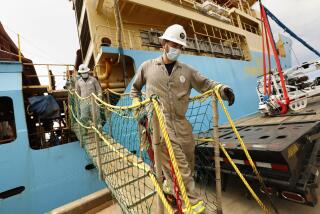How stressed-out microbes survive 500-feet beneath the ocean floor

- Share via
One-third of microbial life on our planet lives in one of the most extreme environments on Earth: deep beneath the ocean floor.
There is no sunlight so photosynthesis is impossible. Dead plant and animal matter drifts down through the water, but it is quickly gobbled up by the fortunate life forms that live closer to the interface between the ocean and the sea floor.
The food that finally does filter down through the layers of sediment is scarce and difficult to digest -- weird complex plant matter, or lipids that are hard for microbes to break down.
And yet, even 500 feet beneath the ocean floor, life continues to hold on.
Scientists discovered the vast community of bacteria, fungi and archaea (a kingdom of single celled organisms) that make up the “deep biosphere” only within the last 15 years. But it wasn’t until the last couple of years that they were able to prove conclusively that these microbes are truly alive, active, and dividing, albeit on a much slower pace than we surface organisms are used to.
Now researchers say they have found the first clues to how these organisms manage to eek out an existence in such a punishing environment.
Expanding on previous work, microbial ecologist William Orsi of the University of Maryland and his colleagues extracted messenger RNA from deep subsurface samples of microbe communities from the continental shelf off the coast of Peru. DNA can survive for thousands of years under the right conditions, but messenger RNA has a short half-life. If you can access mRNA, you can learn what genes a microbial community are currently “turning on.”
In the case of the sub-sea microbes, the researchers found an over expression of a DNA repair gene, as well as the expression of an “SOS” gene that is associated with bacteria that are exposed to antibiotics.
The finding implies that though these microbes are surviving down there, they are not exactly thriving.
“Stress responses occur when you are in the deep biosphere,” Orsi said. “These bugs are just hanging on till the bitter end, hoping to get some food.”
The mRNA analysis also revealed that the microbes are involved in the cycling of all the major elements important for life.
The research, presented Friday at the Goldschmidt conference in Sacramento, has lots of implications. For example, it could help scientists better understand how life on other planets might function. For example, if there is life on Mars, it is very likely that it lives beneath the surface because conditions on the surface are so extreme.
It can also inform the study of the carbon cycle here on Earth.
“The prevailing view is that the carbon in organic matter that sinks to the bottom of the ocean gets sequestered in sediments and does not return to the ocean,” said Orsi. “That needs to be reevaluated now that we know microbes are eating that carbon and respiring it in the form CO2.”
Orsi said he and his colleagues are trying to quantify the impact these subsurface microbes are having on the cycling of elements, and continuing to learn anything they can about this mysterious, massive community.
For more amazing science news, follow me @DeborahNetburn






